| Latest | Greatest | Lobby | Journals | Search | Options | Help | Login |
|
|
|
This topic is archived. |
| Home » Discuss » Topic Forums » Sports |
|
| Jack Rabbit
|
Sun Aug-16-09 03:57 PM Original message |
| The JR Chess Report (August 16): Jermuk, London, Zürich, St. Petersburg and Athens |
|
Leko Leads Jermuk Grand Prix after 7 Rounds
 Hungarian grandmaster Peter Leko leads the latest installment of the FIDE Grand Prix with 5 points in seven rounds in the Armenian health resort Mecca of Jermuk. Tied for second place with 4½ points each are Ukrainian GM Vassily Ivanchuk and Rustam Kasimdzhanov of Uzbekistan. Leko took the lead earlier today when he defeated Bulgarin GM Ivan Cheparinov in 58 moves with Black while Ivanchuk and Kasimdzhanov played each other to a short draw. The three started the day tied for first. Play resumes tomorrow with the eighth round at 15:00 local time (4 am PDT). Leko will have White against Russian GM Dmitry Jakovenko, Ivanchuk plays White against Israel's Boris Gelfand and Kasimdzhanov has Black against former Russian national champion Evgeny Alekseev. The tournament in a thirteen game single round robin among 14 players and runs through August 24. Staunton Memorial Proves to Be a Place for Old Men  The seventh annual Howard Staunton Memorial Tournament at Simpson's Divan in London is proving to be a tournament for old men. This year's edition of the Stuanton is divided into two groups: a Scheveningen team tournament between Britain and Holland and the traditional round robin among ten players. In the Scheveningen Match, British grandmaster Nigel Short, 44, has scored 6 points while former multi-time Dutch national champion Loek van Wely has scored 5 points as the British and Dutch teams are deadlocked after eight rounds with 20 points each. In the round robin, 57-year-old Jan Timman, once a serious world title contender, is tied for first place with 5 points after seven rounds with Russian GM Alexander Cherniaev. Timman held the lead in the rond robin group until Friday's seventh round, when he was beaten by Viktor Korchnoi, now 77 years young. Korchnoi, who came within a hair of winning the world championship from Anatoly Karpov in 1978, has 4 points. Simpson's Divan in London was a Mecca for chess enthusiasts in the middle and late nineteenth century. In addition to Howard Staunton, who was recognized as the world's strongest player in the 1840s, Paul Morphy, Adolf Anderssen and Wilhelm Steinitz, the fist official world champion, played chess at Simpson's. The Immortal Game between Anderssen and Franco-Polish master Lionel Kieseritzky was player there in 1851. The event ends tomorrow. Avrukh, Areshchenko Share First in Zürich CC Jubilee  Boris Avrukh of Israel and Alexander Areschenko of Ukraine shared first place with 7½ points each ahead of heavily favored Russian grandmaster Alexander Morozevich in an open tournament celebrating the 200th anniversary of the founding of the world's oldest chess club still in operation, the Schachgesellschaft Zürich in Switzerland. In the final round, Avrukh defeated Morozevich and Areschenko bested fellow Ukrainian Yuriy Kuzubov. Russian GM Alexey Dreev and Victor Mikhalevsky of Israel tied for third with 7 points. Morozevich finished in a 20-way tied for fifth with 6½ points along with the newly minted 17-year-old American grandmaster Robert Hess and 15-year-old Hou Yifan of China. There were 272 participants in Zürich. Baltic Queen Tournament Opens in St. Petersburg; Pia Cramling and Mrs. Atalik Lead  The Baltic Queen Tournament began Tuesday in St. Petersburg with ten of the top women players in world. Today is a rest day for the lasdies. After five rounds, Swedish grandmastr Pia Cramling and Ekaterina Alalik of Turkey, the wife of Turkish GM Saut Alalik, lead with 4 points each. Tied for third place at 2½ points each are Scottish GM Kevevan Arakhamia-Grant, Lithuanian IM Viktorija Cmilyte and IM Elisabeth Pähtz of Germany. Round Six takes place tomorrow with Pia playing Black Russia's Anatasia Bodnaruk and Mrs. Atalik, also with Black, against Natalia Zhukova of Ukraine. The event concludes Thursday. Acropolis Open underway in Greece 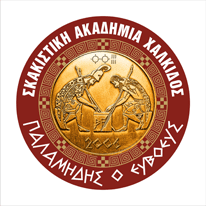 The Acropolis Open began in Athens Monday in Chalkida, about 30 miles from Athens, with 100 participants. After seven rounds, Bosnia GM Borki Predojevic and Ioannis Papaioannou of Greece are in firsst place with 5½ points each. The tournament got off to a tragic start when Greek master Nikolaos Karapanos suffered a heart attack while planning his final moves against Dan Zoler of Israel in the first round. Zoler, a doctor, immediately jumped into action in an attempt to revive Karapanos, but to no avail. Karapanos was taken to a hospital where he was pronouced dead. Dr. Zoler, who was in a completely lost position, resigned the game and, understandably shaken, withdrew from the tournament. The evnets condludes Tuesday. Calendar International Festival d'échecs, Montreal 27 August-7 September. Grandmaster Tournament will include Bacrot, Onischuk, Shulman, Naiditsch and Maze; more to be added. Grand Slam Final, Bilbao 2-15 September. Topalov, Karjakin, Grischuk and Shirov qualify. Topalov dropped and will be replaced by Aronian. Second Pearl Spring Tournament, Nanjing 27 September-9 October. Topalov, Anand, Carlsen, Radjabov, Jakovenko and Wang Yue. World Junior Championship, Mar del Plata (Argentina) 16-29 October. European Club Cup (Team Championship), Novi Sad (Serbia) 21-31 October. World Cup, Khanty Mansiysk 28 November-15 December. London Chess Classic 7-16 December. Corus Chess Tournament, Wijk aan Zee 15-31 January 2010. Nakamura has been invited to play in group A. Anand-Topalov Match for the World Title, Site TBA c. April 2010. |
| Printer Friendly | Permalink | | Top |
| Jack Rabbit
|
Sun Aug-16-09 03:59 PM Response to Original message |
| 1. This week's games |
|
Your humble hare acknowledges the assistance of Fritz 6.0 on analysis. Diagrams on the Jack Rabbit Chess Report are made with Chess Mérida, a true type font that can be downlaoded free here. !""""""""# $tMvWlVmT% $OoOoOoOo% $ + + + +% $+ + + + % $ + + + +% $+ + + + % $pPpPpPpP% $RnBqKbNr% /(((((((() WHITE White to move (This position is a theoretical draw) |
| Printer Friendly | Permalink | | Top |
| Jack Rabbit
|
Sun Aug-16-09 04:01 PM Response to Reply #1 |
| 2. FIDE Grand Prix, Jermuk, Armenia |
| Printer Friendly | Permalink | | Top |
| Jack Rabbit
|
Sun Aug-16-09 04:09 PM Response to Reply #2 |
| 7. Inarkiev - Leko, Round 1 |
 Peter Leko Ernesto Inarkiev - Peter Leko 5th FIDE Grand Prix, Round 1 Jermuk, 9 August 2009 Spanish Grand Royal Game: Anti-Marshall Line (Sofia Opening) 1.e4 e5 2.Nf3 Nc6 3.Bb5 a6 4.Ba4 Nf6 5.0-0 Be7 6.Re1 b5 7.Bb3 0-0
8.h3
8...Bb7
9.d3 d6 10.a3 Qd7
11.Nc3
11...Rfe8
12.Bg5
12...h6 13.Bxf6 Bxf6 14.Nd5 Be7!?
15.c3
15...Nd8 16.d4 exd4 17.Nxd4
17...Bf8!?
18.Re3
18...Bxd5 19.Bxd5 c6 20.Ba2 g6!
21.f4 c5 22.Nc2 c4 23.Kh1
!""""""""# $t+ MtVl+% $+ +w+o+ % $o+ O +oO% $+o+ + + % $ +O+pP +% $P P R +p% $bPn+ +p+% $R +q+ +k% /(((((((() WHITE: Ernesto Inarkiev Position after 23.Kg1h1 23...d5!?
24.exd5 Nb7 25.Qf3 Bc5 26.Re5
26...Bd6!
27.Rxe8+ Rxe8 28.Nd4 Nc5 29.Rf1
29...Ne4 30.Rd1 Qe7 31.g3?
!""""""""# $ + +t+l+% $+ + Wo+ % $o+ V +oO% $+o+p+ + % $ +oNmP +% $P P +qPp% $bP + + +% $+ +r+ +k% /(((((((() WHITE: Ernesto Inarkiev Position after 31.g2g3 31...Bc5!
32.Kg2
32...Nd6
33.Rf1
33...Bxd4 34.cxd4 Nf5 35.Kh2 Qe2+ 36.Qf2
36...Qxf2+ 37.Rxf2 Re1 38.Rd2
38...Kf8 39.g4 Ne3 40.Kg3
40...Ra1 41.Kf3 Nxd5
42.Ke4 !""""""""# $ + + L +% $+ + +o+ % $o+ + +oO% $+o+m+ + % $ +oPkPp+% $P + + +p% $bP R + +% $T + + + % /(((((((() WHITE: Ernesto Inarkiev Position after 42.Kf3e4 42...Nf6+!
43.Ke5 Re1+! 0-1
|
| Printer Friendly | Permalink | | Top |
| Jack Rabbit
|
Sun Aug-16-09 04:11 PM Response to Reply #2 |
| 8. Ivanchuk - Alekseev, Round 4 |
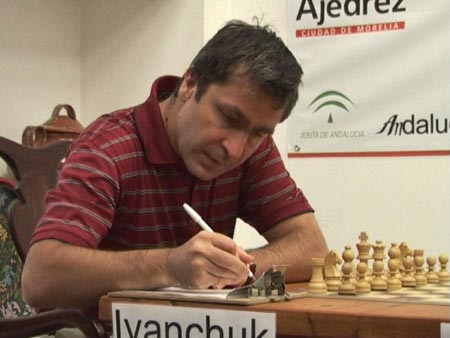 Vassily Ivanchuk Vassily Ivanchuk - Evgeny Alekseev 5th FIDE Grand Prix, Round 4 Jermuk, 12 August 2009 English Game: Agincourt Defense 1.c4 Nf6 2.Nf3 e6
3.g3 d5 4.Bg2 d4 5.0-0 c5
6.e3 Nc6 7.exd4 cxd4 8.d3 Be7 9.Re1 0-0
10.Na3 Ne8 11.Nc2 f6
12.Bd2
12...a5 13.a3 a4 14.Nb4 Nc7 15.Rb1 Bd7 16.Nh4 Na5
17.f4 g6
18.f5 gxf5 19.g4 f4
20.Bxf4 Na6
!""""""""# $t+ W Tl+% $+o+vV +o% $m+ +oO +% $M + + + % $oNpO BpN% $P +p+ + % $ P + +bP% $+r+qR K % /(((((((() WHITE: Vassily Ivanchuk Position after 20...Nc7a6 21.Nd5!?
21...exd5 22.Bxd5+ Kg7 23.Kh1?
23...Re8 24.g5
24...Kh8?
!""""""""# $t+ Wt+ L% $+o+vV +o% $m+ + O +% $M +b+ P % $o+pO B N% $P +p+ + % $ P + + P% $+r+qR +k% /(((((((() WHITE: Vassily Ivanchuk Position after 24...Kg7h8 25.Qh5!
25...Rg8
26.Bxg8 Kxg8
27.g6 Bc6+ !""""""""# $t+ W +l+% $+o+ V +o% $m+v+ Op+% $M + + +q% $o+pO B N% $P +p+ + % $ P + + P% $+r+ R +k% /(((((((() WHITE: Vassily Ivanchuk Position after 27.Bd7c6+ 28.Re4!!
28...Bxe4+ 29.dxe4 hxg6 30.Qxg6+ Kh8 31.Qh5+ 1-0
|
| Printer Friendly | Permalink | | Top |
| Jack Rabbit
|
Sun Aug-16-09 04:02 PM Response to Reply #1 |
| 3. Howard Staunton Memorial Tournament, Spimspn's Divan, London |
| Printer Friendly | Permalink | | Top |
| Jack Rabbit
|
Sun Aug-16-09 04:12 PM Response to Reply #3 |
| 9. Smeets - Short, Scheveningen Match, Round 2 |
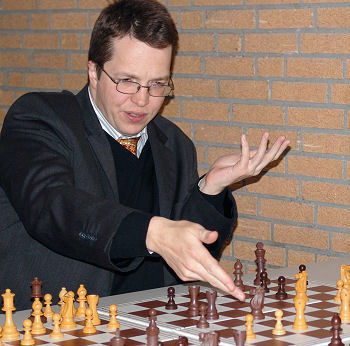 Nigel Short Jan Smeets - Nigel Short Staunton Memorial Tournament (Scheveningen Match), Round 2 London, 9 August 2009 Moorish Game: Horseman Defense (Alekhine's Defense 1.e4 Nf6 2.e5 Nd5 3.d4 d6 4.Nf3 dxe5
5.Nxe5 c6 6.Be2
6...Bf5
7.0-0
7...Nd7 8.c4
8...N5f6!?
9.Bf4
9...Qb6 10.Nxd7 Nxd7 11.Qd2 e5
12.dxe5 0-0-0 13.Nc3
13...Nc5 14.Nd5!?
14...cxd5 15.cxd5 Kb8?
16.Be3!
16...f6!?
17.b4?!
!""""""""# $ L T V T% $Oo+ + Oo% $ W + O +% $+ MpPv+ % $ P + + +% $+ + B + % $p+ QbPpP% $R + +rK % /(((((((() WHITE: Jan Smeets Position after 17.b2b4 17...Ne4!!
18.Bxb6?!
18...Nxd2 19.Bxd8 Bxb4!
20.a3
20...Rxd8 21.axb4 Nxf1 22.Bxf1 fxe5
23.Bc4 a6 24.Re1 e4 25.g4 Bxg4
26.Rxe4 Bf5
27.Re5 g6 28.f4 Kc7 29.Re7+ Rd7 30.Re8!?
30...Kd6 31.b5?
!""""""""# $ + +r+ +% $+o+t+ +o% $o+ L +o+% $+p+p+v+ % $ +b+ P +% $+ + + + % $ + + + P% $+ + + K % /(((((((() WHITE: Jan Smeets Position after 31.b4b5 31...a5! 0-1
|
| Printer Friendly | Permalink | | Top |
| Jack Rabbit
|
Sun Aug-16-09 04:14 PM Response to Reply #3 |
| 10. Timman - Williams, Round Roubin Group, Round 5 |
|
Jan Timman is perhaps the greatest Dutch chess master since the late former world champion, Dr. Max Euwe.
At 57. he isn't the oldest player in London this week. That distinction goes to Viktor Korchnoi, 77 years young, the grand old man of chess. 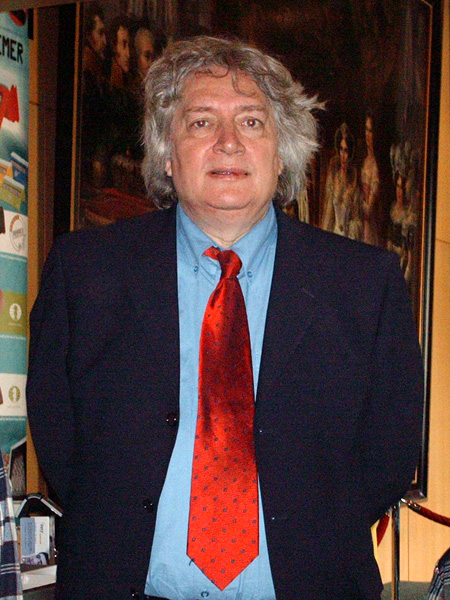 Jan Timman Jan Timman - Simon Williams Staunton Memorial Tournament (Round Robin Group). Round 5 London, 12 August 2009 White Indian Game: Barcza Opening 1.Nf3 Nf6 2.g3 g6 3.b3 Bg7 4.Bb2 0-0 5.Bg2 b5!?
6.Ne5!?
6...c6 7.d4 Qc7 8.0-0 d6 9.Nd3 Bb7 10.Nd2 Nfd7!?
11.c4 bxc4 12.bxc4 a5
!""""""""# $tM + Tl+% $+vWmOoVo% $ +oO +o+% $O + + + % $ +pP + +% $+ +n+ P % $pB MpPbP% $R +q+rK % /(((((((() WHITE: Jan Timman Position after 12...a7a5 13.Qc2!?
13...Na6
14.a3 Rab8
15.Rac1 e5
16.e3 Rfe8
17.Rfe1 exd4
18.Bxd4 Nac5
19.Nxc5 Nxc5 20.Bxc5 dxc5
21.Rb1 Rbd8 22.Bh3
22...Ba6
23.Red1 Qe5 24.Qa4 Qh5?
!""""""""# $ + Tt+l+% $+ + +oVo% $v+o+ +o+% $O O + +w% $q+p+ + +% $P + P Pb% $ + N P P% $+r+r+ K % /(((((((() WHITE: Jan Timman Position after 24...Qe5h5 25.Bg2!
25...Bc8
26.Bxc6 Rf8 27.Bf3 Qe5
28.Qxa5 Bf5 29.Rb5 Bc2 30.Rc1 Qf5
!""""""""# $ + T Tl+% $+ + +oVo% $ + + +o+% $QrO +w+ % $ + + + +% $P + PbP % $ +vN P p% $+ R + K % /(((((((() WHITE: Jan Timman Position after 30...Qe5f5 31.e4!
31...Qf6 32.Rxc2 Rxd2 33.Qxd2 Qxf3 34.Rxc5 1-0
|
| Printer Friendly | Permalink | | Top |
| Jack Rabbit
|
Sun Aug-16-09 04:04 PM Response to Reply #1 |
| 4. Zürich Chess Club Jubilee Open |
| Printer Friendly | Permalink | | Top |
| Jack Rabbit
|
Sun Aug-16-09 04:16 PM Response to Reply #4 |
| 11. Hess - Areshchenko, Round 2 |
 Alexander Areshchenko Robert Hess - Alexander Areshchenko Zürich Chess Club Jubilee Open.Round 2 Zürich, 11 August 2009 Spanish Sicilian Game: Canal Defense 1.e4 c5 2.Nf3 d6 3.Bb5+ Nc6 4.0-0
4...Bd7 5.Re1 Nf6 6.c3 a6 7.Ba4
7...b5 8.Bc2 e5
9.d4
9...cxd4 10.cxd4 Bg4 11.Be3
11...exd4!?
12.Bxd4
12...Be7 13.Nc3 0-0 14.a3 Rc8 15.Qd3 Bh5
16.Bb3 Nd7 17.Bd5
17...Nc5!?
18.Qe3!
18...Re8
19.b4 Bxf3 20.Bxc6 Rxc6 21.Qxf3 Ne6!?
22.Rad1!?
22...Rc4 23.Ne2
23...Qa8 24.Qe3 Bg5 25.Qg3!?
!""""""""# $w+ +t+l+% $+ + +oOo% $o+ Om+ +% $+o+ + V % $ PtB + +% $P + + Q % $ + +mPpP% $+ +rR K % /(((((((() WHITE: Robert Hess Position after 25.Qe3g3 25...Qxe4!
26.Bc3?!
26...Qc2!
27.Rxd6 Re4 28.f4?
28...Nxf4!
29.Rd2 Nxe2+ 30.Rexe2 Qc1+ 31.Kf2 !""""""""# $ + +t+l+% $+ + +oOo% $o+ + + +% $+o+ + V % $ P +t+ +% $P B + Q % $ + RrKpP% $+ W + + % /(((((((() WHITE: Robert Hess Position after 31.Kg1f2 31...Qxd2!!
32.Rxd2
32...Bh4 0-1
|
| Printer Friendly | Permalink | | Top |
| Jack Rabbit
|
Sun Aug-16-09 04:18 PM Response to Reply #4 |
| 12. Avrukh - Berend, Round 2 |
 Boris Avrukh Boris Avrukh - Fred Berend Zürich Chess Club Jubilee Open. Round 2 Zürich, 10 August 2009 Semi-Slav Queen's Gambit: Chameleon Defense 1.d4 Nf6 2.c4 e6 3.Nf3 d5 4.Nc3 c6 5.e3 a6
6.c5 Nbd7 7.b4 g6 8.Bd3 Bg7 9.0-0 0-0 10.Na4 a5!?
11.b5
11...Ne4 12.Bb2 f5
13.Qc2 g5 14.Ne5 Nxe5 15.dxe5 g4 16.f3 gxf3 17.gxf3 Ng5 18.Kh1
18...Kh8 19.Qg2 Rg8
20.Rg1 h6 21.Bd4!? <[br />
!""""""""# $t+vW +tL% $+o+ + V % $ +o+o+ O% $OpPoPoM % $n+ B + +% $+ +bPp+ % $p+ + +qP% $R + + Rk% /(((((((() WHITE: Boris Avrukh Position after 21.Bb2d4 21...Bd7 22.Nc3 Qe8
23.bxc6 Bxc6 24.Be2 Qe7 25.Qg3
25...a4 26.Rg2 Nh7?
!""""""""# $t+ + +tL% $+o+ W Vm% $ +v+o+ O% $+ PoPo+ % $o+ B + +% $+ N pPQ % $p+ +b+rP% $+ + + +k% /(((((((() WHITE: Boris Avrukh Position after 26...Ng5h7 27.Rag1! the fully loaded cannon on the g-file greatly restricts the movement of Black's pieces. Black must keep g7 occupied and covered three times. 27...Nf8 28.Bd3!
28...Nd7 29.Ne2 Nf8
30.Nf4 Be8 31.Qh3!
31...Rd8 !""""""""# $ + TvMtL% $+o+ W V % $ + +o+ O% $+ PoPo+ % $o+ B N +% $+ +bPp+q% $p+ + +rP% $+ + + Rk% /(((((((() WHITE: Boris Avrukh Position after 31...Ra8d8 32.Bxf5!!
32...exf5 33.e6!!
33...Bxd4 34.Qxh6+! 1-0
|
| Printer Friendly | Permalink | | Top |
| Jack Rabbit
|
Sun Aug-16-09 04:06 PM Response to Reply #1 |
| 5. Baltic Queen Tournament, St. Petersburg |
| Printer Friendly | Permalink | | Top |
| Jack Rabbit
|
Sun Aug-16-09 04:19 PM Response to Reply #5 |
| 13. Peng - Cramling, Round 2 |
 Pia Cramling To view this game:
Peng Zhaoqin - Pia Cramling Baltic Queen Tournament, Round 2 St. Petersburg, 12 August 2009 East India Game: Queen's Indian Defense 1.d4 Nf6 2.Nf3 e6 3.c4 b6 4.g3 Bb4+
5.Bd2 a5
6.Bg2 Bb7 7.Nc3
7...0-0 8.0-0 d6 9.Qc2 Bxc3
10.Bxc3 Be4 11.Qd2
11...Nbd7!?
12.Rfd1
12...Qb8 13.Bh3 h6 14.d5 e5
15.Nh4 b5 16.cxb5 Qxb5 17.a4
17...Qb6 18.Nf5 Rfe8
19.Ne3 Qa6!?
20.Bxd7 Nxd7 21.b4 axb4 22.Bxb4 Reb8 23.Qc3??
!""""""""# $tT + +l+% $+ Om+oO % $w+ O + O% $+ +pO + % $pB +v+ +% $+ Q N P % $ + +pP P% $R +r+ K % /(((((((() WHITE: Peng Zhaoqin Position after 23.Qd2c3 23...Qxe2! 0-1
|
| Printer Friendly | Permalink | | Top |
| Jack Rabbit
|
Sun Aug-16-09 04:20 PM Response to Reply #5 |
| 14. E. Atalik - Cmilyte, Round 1 |
 Ekaterina Atalik To view this game:
Ekaterina Atalik - Viktorija Cmilyte Baltic Queen Tournament, Round 1 St. Petersburg, 11 August 2009 West India Game: Tal-Indian Defense (Catalan Opening) 1.d4 Nf6 2.c4 e6 3.Nf3 c5 4.d5 d6 5.Nc3 exd5 6.cxd5 g6 7.g3
7...Bg7 8.Bg2 0-0 9.0-0 Re8 10.a4 a6 11.Re1
11...Nbd7 12.e4 12...Qc7
13.Bf4!?
13...Ng4
14.Rc1 c4
15.Nd2 Nde5 16.h3!?
16...Nxf2!
17.Kxf2 Nd3+ 18.Kg1!?
18...Nxb2!
19.Qf3 Nd3 20.Kh2?
!""""""""# $t+v+t+l+% $+oW +oVo% $o+ O +o+% $+ +p+ + % $p+o+pB +% $+ Nm+qPp% $ + N +bK% $+ R R + % /(((((((() WHITE: Ekaterina Atalik Position after 20.Kg1h2 20...Bxc3!
21.Nxc4!?
21...Nxf4?!
22.Qxf4
22...Qxc4 23.Re3 Bd7?!
!""""""""# $t+ +t+l+% $+o+v+o+o% $o+ O +o+% $+ +p+ + % $p+w+pQ +% $+ V R Pp% $ + + +bK% $+ R + + % /(((((((() WHITE: Ekaterina Atalik Position after 23...Bc8d7 24.Rexc3!
24...Qxa4 25.Qxd6 Rad8 26.Qf6 Qb4
27.Rc7 a5
28.Rf1 Rf8?
!""""""""# $ + T Tl+% $+oRv+o+o% $ + + Qo+% $O +p+ + % $ W +p+ +% $+ + + Pp% $ + + +bK% $+ + +r+ % /(((((((() WHITE: Ekaterina Atalik Position after 28...Re8f8 29.h4!
29...Qd2
30.Qe7 Rc8
31.Qxd7 Rxc7 32.Qxc7 b5
33.e5 a4 34.e6 1-0
|
| Printer Friendly | Permalink | | Top |
| Jack Rabbit
|
Sun Aug-16-09 04:08 PM Response to Reply #1 |
| 6. Arctic Chess Challenge, Tromsø |
| Printer Friendly | Permalink | | Top |
| Jack Rabbit
|
Sun Aug-16-09 04:22 PM Response to Reply #6 |
| 15. M. Socko - Sulskis, Round 6 |
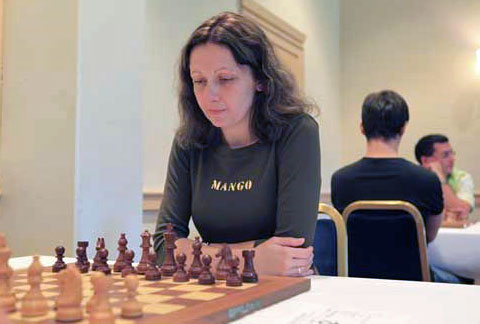 Monika Socko To view this game:
Monika Socko - Sarunas Sulskis Arctic Chess Challenge, Round 6 Tromsø, 6 August 2009 Open Sicilian Game: Anderssen Defense 1.e4 c5 2.Nf3 e6 3.d4 cxd4 4.Nxd4 Nf6 5.Nc3 Bb4 6.e5
6...Nd5 7.Bd2 Nxc3 8.bxc3 Be7 9.Qg4 0-0
10.Bd3!?
10...d6 11.f4!?
11...Nd7!?
12.exd6 Bh4+ 13.g3 Bf6 14.Nf3!?
14...g6!
15.0-0?!
15...Qb6+ 16.Rf2 Qxd6 17.Re1
17...b6 18.h4?
18...h5 19.Qh3 e5!?
20.Qf1 exf4?
21.Bxf4 Qa3 !""""""""# $t+v+ Tl+% $O +m+o+ % $ O + Vo+% $+ + + +o% $ + + B P% $W Pv+nP % $p+p+ R +% $+ + RqK % /(((((((() WHITE: Monika Socko Position after 21...Qd6a3 22.Nd4!
22...Bxd4 23.cxd4 Bb7 24.Bh6 Qd6
25.Kh2 Qxd4 26.Bxf8 Rxf8 !""""""""# $ + + Tl+% $Pv+m+o+ % $ P + +o+% $+ + + +o% $ + W + P% $+ +b+ P % $p+p+ R K% $+ + Rq+ % /(((((((() WHITE: Monika Socko Position after 26...Ra8f8:B 27.Re7!
27...Ne5 28.Rxb7 Ng4+ 29.Kg1 f5
30.Re7 Kh8 31.Kg2 Rf7 32.Rfe2 Rxe7
33.Rxe7 Ne3+ 34.Rxe3 Qxe3
35.Qf4 Qe6 36.Qb8+ Kg7 37.Qxa7+ Kf6 38.Qa8 Qd6 39.Qh8+ Ke7 40.Qg7+ Kd8 41.Qg8+ Kc7 42.Qc4+ 1-0
|
| Printer Friendly | Permalink | | Top |
| Jack Rabbit
|
Sun Aug-16-09 04:23 PM Response to Reply #6 |
| 16. Robson - Malakhatko, Round 5 |
|
Fourteen-year-old US IM Ray Robson won his first grandmaster norm in Tromsø.
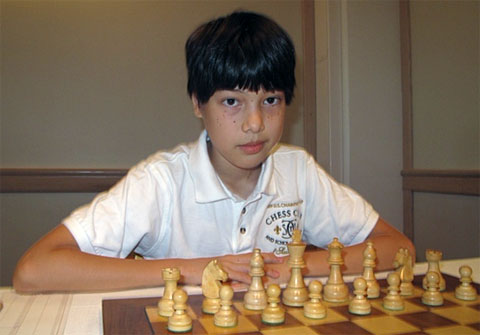 Ray Robson To view this game:
Ray Robson - Vadim Malakhatko Arctic Chess Challenge, Round 5 Tromsø, 5 August 2009 Open German Game: Seirawan Defense (Caro-Kann Defense) 1.e4 c6 2.d4 d5 3.Nc3 dxe4 4.Nxe4 Bf5 5.Ng3 Bg6 6.h4 h6 7.Nf3 Nd7 8.h5
8...Bh7 9.Bd3 Bxd3 10.Qxd3 e6 11.Bd2
11...Ngf6 12.0-0-0 Be7
13.Qe2
13...0-0 14.Nf1
14...c5
15.g4 cxd4 16.g5 hxg5 17.Bxg5 Nd5!?
18.Bxe7 Qxe7 19.Rxd4
19...Qf6 20.Kb1!?
20...Qh6!
21.c4 Rac8 22.Qd1 N5f6
23.Ne3 Nc5!?
!""""""""# $ +t+ Tl+% $Oo+ +oO % $ + +oM W% $+ M + +p% $ +pR + +% $+ + Nn+ % $pP + P +% $+k+q+ +r% /(((((((() WHITE: Ray Robson Position after 23...Nd7c5 24.Ne5!
24...Nce4 25.Qf3
25...Qh7 26.Ka1 Rcd8
27.Rxd8!?
27...Rxd8 28.h6 Rd2?
!""""""""# $ + + +l+% $Oo+ +oO % $ + +oM P% $+ + Nw+ % $ +p+m+n+% $+ + +q+ % $pP T P +% $K + + +r% /(((((((() WHITE: Ray Robson Position after 28...Rd8d2 29.N3g4!
29...Qf5
30.Nxf6+ Nxf6 31.Qxb7 Qh5
32.a3 Rd1+
!""""""""# $ + + +l+% $Oq+ +oO % $ + +oM P% $+ + N +w% $ +c+ + +% $P + + + % $ P + P +% $K +t+ +r% /(((((((() WHITE: Ray Robson Position after 32...Rd2d1+ 33.Rxd1
33...Qxd1+ 34.Ka2 Qh5 35.Qa8+
35...Kh7 36.hxg7 Kxg7 37.f4 Qf5 38.Qxa7 Nh5
39.Qd4 Qxf4 40.Qxf4 Nxf4 41.a4 1-0
|
| Printer Friendly | Permalink | | Top |
| DU
AdBot (1000+ posts) |
Thu May 02nd 2024, 03:04 AM Response to Original message |
| Advertisements [?] |
| Top |
| Home » Discuss » Topic Forums » Sports |
|
Powered by DCForum+ Version 1.1 Copyright 1997-2002 DCScripts.com
Software has been extensively modified by the DU administrators
Important Notices: By participating on this discussion board, visitors agree to abide by the rules outlined on our Rules page. Messages posted on the Democratic Underground Discussion Forums are the opinions of the individuals who post them, and do not necessarily represent the opinions of Democratic Underground, LLC.
Home | Discussion Forums | Journals | Store | Donate
About DU | Contact Us | Privacy Policy
Got a message for Democratic Underground? Click here to send us a message.
© 2001 - 2011 Democratic Underground, LLC